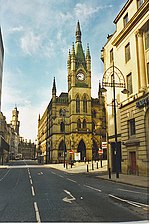Bradford Exchange railway station

Bradford Exchange railway station served the city of Bradford, West Riding of Yorkshire, England, from 1850 to 1973, before being replaced by a smaller, new-build station, which was later called Bradford Interchange. Railway lines from Halifax, Queensbury, Wakefield and Leeds met south of the city centre with services terminating in the station. In the British Rail era, many services did not terminate at Exchange station but became through services which reversed in the station to carry on their journey. Exchange station was originally opened in 1850 by the Lancashire & Yorkshire Railway (L&YR) as Drake Street, becoming Exchange in April 1867 with the arrival of services from the Great Northern Railway (GNR). It was enlarged in 1888 and closed in 1973, with the station moving to a new 4-platform site a little further south.
Excerpt from the Wikipedia article Bradford Exchange railway station (License: CC BY-SA 3.0, Authors, Images).Bradford Exchange railway station
Vicar Lane, Bradford Bowling
Geographical coordinates (GPS) Address Nearby Places Show on map
Geographical coordinates (GPS)
| Latitude | Longitude |
|---|---|
| N 53.792 ° | E -1.749 ° |
Address
Vicar Lane
BD1 5LD Bradford, Bowling
England, United Kingdom
Open on Google Maps










